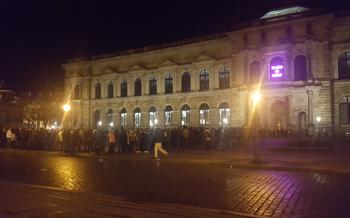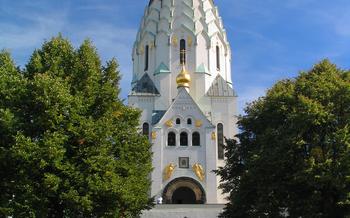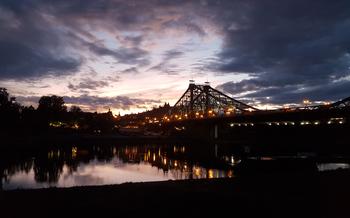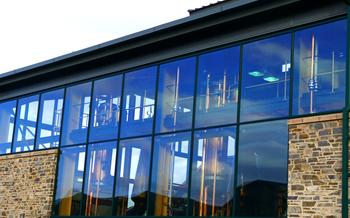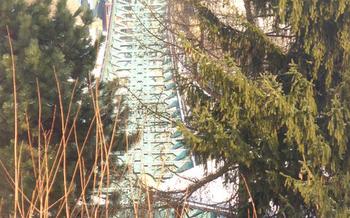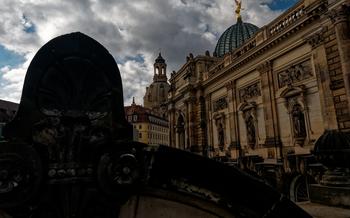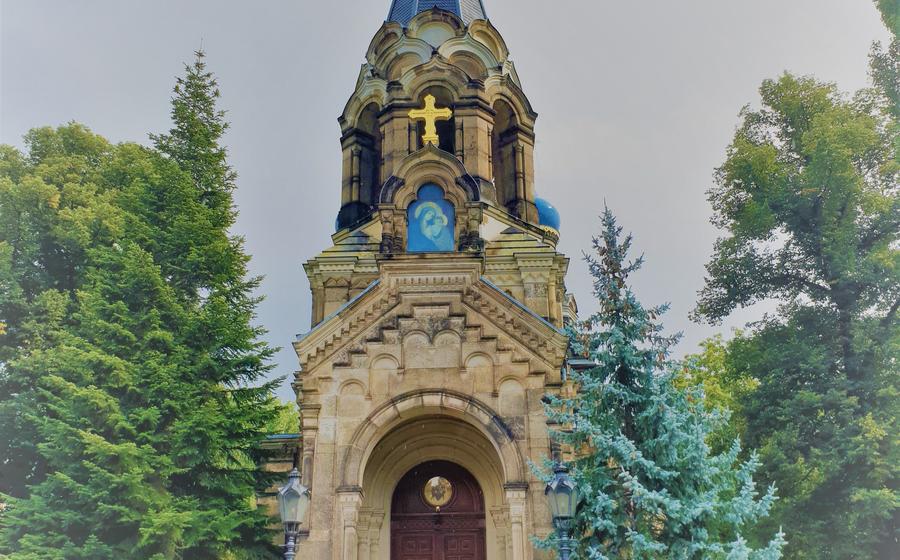
Russian Orthodox Church
- Dresden's Russian Orthodox Church: A Symbol of Cultural Heritage
- Location and Accessibility
- Opening Hours and Admission Fees
- Guided Tours and Audio Guides
- Dress Code and Etiquette
- Highlights of the Interior
- Services and Liturgies
- Significance to the Russian Community
- Nearby Attractions
- Photography and Videography
- Events and Activities
- History and Construction
- Restoration and Preservation
- Unique Features and Symbolism
- Insider Tip: Hidden Gem
Dresden's Russian Orthodox Church: A Symbol of Cultural Heritage
Historical Significance
Nestled in the heart of Dresden's historic Neustadt district, the Russian Orthodox Church stands as a resplendent testament to the city's rich multicultural history. Its origins can be traced back to the 18th century when Dresden served as a prominent hub for Russian diplomats and merchants. In response to the growing Russian community's need for a dedicated place of worship, the foundation stone for the church was laid in 1872, marking a significant milestone in the city's religious landscape.
Architectural Features
The church's striking neo-Byzantine architectural style, characterized by its distinctive onion domes and intricate brickwork, is a testament to the eclectic mix of influences that shaped Dresden's cityscape. The building's facade is adorned with elaborate carvings and colorful mosaics, showcasing the exceptional craftsmanship and artistic vision of its creators. The interior of the church is equally impressive, boasting a magnificent iconostasis, intricate frescoes, and opulent chandeliers, creating an awe-inspiring ambiance.
Religious Importance
The Russian Orthodox Church in Dresden holds immense religious significance for the city's Russian Orthodox community. It serves as a spiritual haven where members can gather for worship, prayer, and fellowship. The church also plays a crucial role in preserving and promoting Russian Orthodox traditions and culture, fostering a sense of unity and belonging among its congregation.
Must-See Attraction
With its captivating history, stunning architecture, and profound religious significance, the Russian Orthodox Church has become a must-see attraction for visitors to Dresden. Whether you're drawn to its architectural beauty, cultural heritage, or spiritual essence, this remarkable landmark offers a unique and enriching experience that will leave a lasting impression.
Location and Accessibility
The Dresden's Russian Orthodox Church is conveniently located at Antonstraße 1, in the heart of Dresden's historic city center. Its proximity to various landmarks and attractions makes it easily accessible for visitors.
To reach the church, you can take advantage of Dresden's efficient public transportation system. The closest tram stop is Antonstraße, served by tram lines 6 and Several bus lines, including lines 62, 63, and 75, also stop nearby.
For those arriving by car, limited street parking is available in the surrounding area. However, it is advisable to use public transportation or consider parking in one of the nearby parking garages for a more convenient and stress-free visit.
The church is wheelchair accessible, ensuring that visitors with disabilities can fully experience its beauty and grandeur. A designated ramp at the entrance provides easy access for those with mobility limitations.
Opening Hours and Admission Fees
The Russian Orthodox Church in Dresden welcomes visitors from all over the world with open arms. It is open to the public daily, except for major religious holidays and events. Visitors are encouraged to check the church's website or contact the parish office in advance to confirm the opening hours and any special arrangements.
Regular Opening Hours:
- Monday to Saturday: 10:00 am to 5:00 pm
- Sunday: 12:00 pm to 5:00 pm
Admission Fees:
- Adults: 5 euros
- Children (under 18): Free
- Families (two adults and two children): 12 euros
The church also offers free admission on certain days, such as religious holidays and during special events. Visitors can check the church's website or inquire at the parish office for more information.
Guided Tours and Audio Guides
The Russian Orthodox Church in Dresden offers guided tours for visitors who wish to delve deeper into its history, architecture, and religious significance. These tours are led by knowledgeable guides who provide insights into the church's unique features, symbolism, and cultural importance. Guided tours are available in various languages, including English, German, and Russian, to accommodate visitors from diverse backgrounds.
The cost of guided tours varies depending on the group size and the duration of the tour. Visitors can choose from a variety of tour options, ranging from standard tours to more in-depth experiences. Advance booking is recommended to secure a spot, especially during peak tourist season.
In addition to guided tours, the church also offers audio guides for self-guided exploration. These audio guides provide a comprehensive commentary on the church's history, architecture, and religious significance. Visitors can rent audio guides at the church entrance for a nominal fee.
Whether you prefer a guided tour or an audio guide, exploring the Russian Orthodox Church in Dresden with the help of an expert guide or an audio commentary will greatly enhance your understanding and appreciation of this architectural and cultural treasure.
Dress Code and Etiquette
When visiting the Russian Orthodox Church in Dresden, it is essential to adhere to the established dress code and etiquette to honor religious sentiments and maintain a respectful atmosphere.
Appropriate Attire:
- Modest Clothing: Dress conservatively, avoiding revealing or overly casual attire. Opt for clothing that covers your shoulders and knees.
- Formal Wear: While not mandatory, consider dressing formally, especially if attending a special service or event.
- Head Coverings: Women are encouraged to cover their heads with a headscarf or shawl as a sign of respect and humility.
Prohibited Items:
- Shorts and Tank Tops: These items are considered too casual and disrespectful for the sacred space.
- Hats and Caps: Men should remove their hats or caps upon entering the church.
- Loud or Flashy Clothing: Avoid wearing clothing that draws excessive attention or disrupts the serene ambiance.
Respectful Behavior:
- Silence and Reverence: Maintain silence while inside the church, allowing for contemplation and prayer.
- Bowing and Crossing: When entering and exiting the church, it is customary to bow or make the sign of the cross as a gesture of reverence.
- Photography and Videography: Photography and videography are generally permitted, but be mindful of others and avoid using flash or tripods.
- Prayer and Worship: If attending a service, observe the rituals and traditions with respect. Feel free to join in prayer or simply sit quietly and reflect.
Highlights of the Interior
As you step inside Dresden's Russian Orthodox Church, you'll be greeted by a breathtaking display of religious art and architecture. The iconostasis, or screen that separates the nave from the altar, is a masterpiece of craftsmanship. Its intricate carvings and gleaming gold leaf depict scenes from the Bible and the lives of saints. The walls and ceilings are adorned with elaborate frescoes and mosaics, telling stories of faith, hope, and redemption. The ornate chandeliers and candlesticks, suspended from the vaulted ceilings, cast a warm and inviting glow, creating a sense of awe and reverence. The overall atmosphere inside the church is one of peace and tranquility, inviting you to reflect on the spiritual and historical significance of this sacred space.
Services and Liturgies
The Russian Orthodox Church in Dresden offers a regular schedule of services and liturgies that are open to the public. Services are typically conducted in Church Slavonic, the traditional liturgical language of the Orthodox Church. However, some services may also be conducted in German or English to accommodate international visitors.
The main Sunday liturgy, known as the Divine Liturgy, is held every Sunday morning. It begins at 10 am and typically lasts for about two hours. The service includes readings from the Bible, prayers, hymns, and the Eucharist, which is the central sacrament of the Orthodox Church.
Visitors are welcome to attend any of the services, but it is important to be respectful of the religious nature of the ceremonies. Proper attire is also expected, as outlined in the dress code section of this guide.
If you are interested in participating in a service, it is advisable to arrive a few minutes early to allow time for the purchase of candles and other items. You can also speak to the priest or other church officials if you have any questions or need assistance.
Attending a service at the Russian Orthodox Church in Dresden is a unique opportunity to experience the rich cultural and spiritual traditions of the Russian Orthodox faith. Whether you are a practicing Orthodox Christian or simply interested in learning more about this ancient religion, the church offers a welcoming and enriching environment for all visitors.
Significance to the Russian Community
The Russian Orthodox Church in Dresden holds immense significance for the Russian community in the city and beyond. It serves as a cultural and religious center, fostering a sense of unity and belonging among Russian expats. Throughout history, Dresden has maintained close historical ties with Russia, dating back to the 18th century when the city became a popular destination for Russian travelers and diplomats. The presence of a Russian Orthodox church in Dresden symbolizes the enduring friendship and cooperation between the two nations. It represents a tangible link to their shared cultural heritage and serves as a gathering place for the Russian community to celebrate their traditions, observe religious rituals, and connect with their roots.
Nearby Attractions
Dresden's Russian Orthodox Church is surrounded by a wealth of cultural and historical attractions that enhance the visitor experience. Within walking distance, one can find the magnificent Frauenkirche, a symbol of resilience and reconstruction after the devastating bombing of Dresden during World War II. The Semperoper, a world-renowned opera house, captivates audiences with its grand architecture and exceptional performances.
For art enthusiasts, the Gemäldegalerie Alte Meister (Old Masters Picture Gallery) houses an impressive collection of masterpieces by renowned artists such as Raphael, Titian, and Rembrandt. The Albertinum, a former arsenal now transformed into a museum complex, showcases a diverse range of art and sculpture from different eras.
Dresden is also home to several beautiful parks and gardens that provide a tranquil respite from the city's bustling streets. The Großer Garten (Great Garden), one of the largest parks in Germany, offers vast lawns, picturesque ponds, and a botanical garden. The Zwinger, an opulent palace complex, boasts stunning gardens adorned with intricate sculptures and fountains.
When it comes to shopping and dining, Dresden offers a delightful array of options. The Prager Straße, located near the Russian Orthodox Church, features a vibrant mix of shops, boutiques, and restaurants. The Striezelmarkt, Germany's oldest Christmas market, takes place annually in the heart of the city, offering a festive atmosphere and an array of traditional delicacies.
Photography and Videography
The Russian Orthodox Church in Dresden welcomes photography and videography for personal use, allowing visitors to capture the stunning beauty of its interiors and exteriors. However, certain restrictions apply to ensure the respectful and orderly conduct of visitors within the sacred space.
Flash photography and the use of tripods are not permitted inside the church, as they can be disruptive to ongoing services and disturb the peaceful atmosphere. Photography and videography for commercial purposes require prior permission from the church authorities.
Visitors are encouraged to be mindful of other visitors and avoid blocking their views or causing any disruption during services or events. By following these guidelines, visitors can respectfully document their visit while preserving the sacred ambiance of the church.
Events and Activities
The Russian Orthodox Church in Dresden is not just a place of worship but also a vibrant center for cultural and religious events. Throughout the year, the church hosts a variety of concerts, exhibitions, and cultural events that showcase the rich traditions and heritage of the Russian Orthodox community. These events often feature performances by renowned musicians, choirs, and dance troupes, as well as displays of traditional Russian art and crafts.
One of the highlights of the church's calendar is the annual Russian Orthodox Christmas festival, which takes place in January. During this festive celebration, the church is adorned with colorful decorations, and a variety of traditional Russian food, music, and dance performances fill the air. Visitors can also enjoy a traditional Russian Christmas market, where they can purchase unique gifts and souvenirs.
For those interested in learning more about the history and culture of the Russian Orthodox Church, guided tours are available in several languages. These tours provide visitors with a deeper insight into the church's architecture, iconography, and religious practices. Visitors are also welcome to attend services and liturgies, which are conducted in both Russian and German.
History and Construction
The history of the Russian Orthodox Church in Dresden dates back to the 18th century when a significant number of Russian expatriates settled in the city. As their community grew, the need for a dedicated place of worship became increasingly apparent. In 1866, a group of Russian nobles and merchants initiated a fundraising campaign to build a Russian Orthodox church in Dresden.
The construction of the church began in 1872 under the direction of renowned Russian architect Konstantin Thon, who also designed the Cathedral of Christ the Savior in Moscow. Thon's design for the Dresden church was inspired by traditional Russian Orthodox architecture, incorporating elements such as onion domes, intricate carvings, and colorful frescoes.
The church was completed in 1875 and consecrated by the Bishop of Riga and Mitau. It quickly became a spiritual and cultural center for the Russian community in Dresden, as well as a symbol of the close ties between Russia and Germany.
Restoration and Preservation
The Russian Orthodox Church in Dresden has undergone several phases of restoration and preservation to maintain its historical integrity. In the aftermath of World War II, the church sustained significant damage due to bombings. The reconstruction efforts began in the 1950s and involved meticulous restoration work, including the repair of the roof, exterior walls, and interior decorations.
One of the challenges faced during the restoration process was the need to balance the preservation of original features with the incorporation of modern techniques to ensure structural stability. The church's iconic onion domes, for example, required specialized expertise to restore their original splendor while adhering to modern building codes.
Ongoing conservation projects aim to preserve the church's unique architectural elements and artistic treasures for future generations. Regular maintenance and cleaning are carried out to prevent deterioration, while experts monitor the condition of the building to identify potential risks and address them promptly.
The Russian Orthodox community in Dresden plays a vital role in preserving the church's heritage by actively fundraising and supporting restoration initiatives. Their dedication to maintaining the church as a symbol of their faith and a cultural landmark is a testament to its enduring significance.
Unique Features and Symbolism
The Dresden Russian Orthodox Church exhibits several distinctive architectural elements that set it apart from other Orthodox churches. Its onion-shaped domes, a hallmark of Russian architecture, symbolize heaven and eternal life. The intricate carvings and decorations adorning the exterior and interior depict biblical scenes and stories, serving as a visual narrative of the Christian faith. The church's location on the banks of the Elbe River, a symbol of life and renewal, further enhances its spiritual significance.
Beyond its architectural features, the church holds profound symbolic meaning. Its construction was seen as a symbol of unity and cooperation between the Russian and German communities in Dresden. The church's dedication to St. Simeon and St. Anna, the parents of the Virgin Mary, emphasizes the importance of family and tradition within the Russian Orthodox faith. The church's survival through turbulent historical events, including two world wars, stands as a testament to the resilience of the Russian Orthodox community and the enduring power of faith.
Insider Tip: Hidden Gem
Beyond its stunning interior and historical significance, the Russian Orthodox Church holds a secret that only a few know about. Deep within the church's crypt lies a hidden chamber, accessible through a discreet door concealed behind an iconostasis. This secret chamber once served as a refuge for persecuted Russian Orthodox believers during times of religious oppression. Today, it stands as a testament to the resilience and faith of the Russian community in Dresden.
If you're lucky enough to stumble upon this hidden gem, take a moment to reflect on the stories it holds. Imagine the whispers of prayers and the hushed conversations that echoed through this chamber as believers sought solace and strength in their faith. It's a truly unique and moving experience that will give you a deeper appreciation for the church's significance and the enduring spirit of the Russian Orthodox community.
